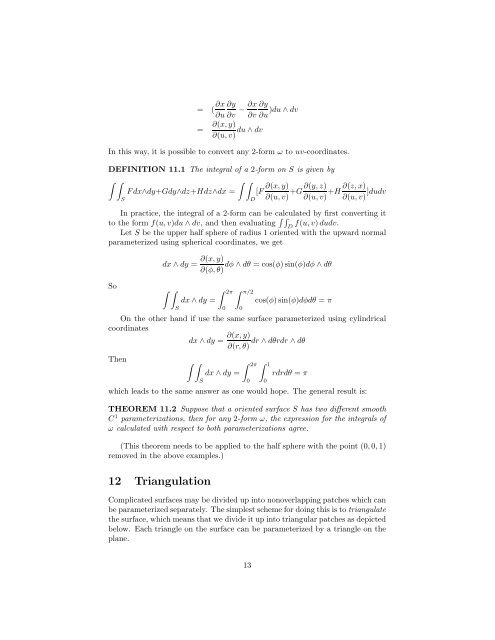Introduction to differential forms
Introduction to differential forms
Introduction to differential forms
You also want an ePaper? Increase the reach of your titles
YUMPU automatically turns print PDFs into web optimized ePapers that Google loves.
= ( ∂x ∂y<br />
∂u ∂v − ∂x ∂y<br />
)du ∧ dv<br />
∂v ∂u<br />
∂(x, y)<br />
= du ∧ dv<br />
∂(u, v)<br />
In this way, it is possible <strong>to</strong> convert any 2-form ω <strong>to</strong> uv-coordinates.<br />
DEFINITION 11.1 The integral of a 2-form on S is given by<br />
∫ ∫<br />
∫ ∫<br />
∂(x, y) ∂(y, z) ∂(z, x)<br />
F dx∧dy+Gdy∧dz+Hdz∧dx = [F +G +H<br />
∂(u, v) ∂(u, v) ∂(u, v) ]dudv<br />
S<br />
In practice, the integral of a 2-form can be calculated by first converting it<br />
<strong>to</strong> the form f(u, v)du ∧ dv, and then evaluating ∫ ∫ D<br />
f(u, v) dudv.<br />
Let S be the upper half sphere of radius 1 oriented with the upward normal<br />
parameterized using spherical coordinates, we get<br />
So<br />
dx ∧ dy =<br />
∫ ∫<br />
S<br />
dx ∧ dy =<br />
D<br />
∂(x, y)<br />
dφ ∧ dθ = cos(φ) sin(φ)dφ ∧ dθ<br />
∂(φ, θ)<br />
∫ 2π ∫ π/2<br />
0<br />
0<br />
cos(φ) sin(φ)dφdθ = π<br />
On the other hand if use the same surface parameterized using cylindrical<br />
coordinates<br />
∂(x, y)<br />
dx ∧ dy = dr ∧ dθrdr ∧ dθ<br />
∂(r, θ)<br />
Then<br />
∫ ∫<br />
S<br />
dx ∧ dy =<br />
∫ 2π ∫ 1<br />
0<br />
0<br />
rdrdθ = π<br />
which leads <strong>to</strong> the same answer as one would hope. The general result is:<br />
THEOREM 11.2 Suppose that a oriented surface S has two different smooth<br />
C 1 parameterizations, then for any 2-form ω, the expression for the integrals of<br />
ω calculated with respect <strong>to</strong> both parameterizations agree.<br />
(This theorem needs <strong>to</strong> be applied <strong>to</strong> the half sphere with the point (0, 0, 1)<br />
removed in the above examples.)<br />
12 Triangulation<br />
Complicated surfaces may be divided up in<strong>to</strong> nonoverlapping patches which can<br />
be parameterized separately. The simplest scheme for doing this is <strong>to</strong> triangulate<br />
the surface, which means that we divide it up in<strong>to</strong> triangular patches as depicted<br />
below. Each triangle on the surface can be parameterized by a triangle on the<br />
plane.<br />
13








